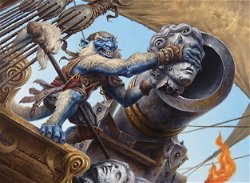About Jund Affinity
The Pauper meta is still evolving after the recent changes, and we keep seeing interesting results, one after the other. High Tide is still performing well, though it hasn't been as popular as other lists. Faeries, Tolarian Terror, and Bogles lead the meta, and Burn has come out from the ashes to fill the hole left by Kuldotha Red.
Affinity is still a strong deck, but the Grixis version has been, apparently, a bit overshadowed by all the other changes. With this in mind, I decided to explore another version of Affinity, one that leaves blue behind. This color, which before seemed to be so vital for this deck, particularly to get cards like Hydroblast and Kenku Artificer, is now behind us.
Now, we have found space for a new approach. Let's explore Jund Affinity!
Why Play Jund Affinity
Jund Affinity is, predominantly, a Rakdos list that splashes to green and, as such, can access specific cards that add a lot of value to this strategy. This deck's familiar core includes creatures with Affinity, card advantage, and powerful removals.

Ad
The most significant differences are the green cards, like Nyxborn Hydra in the main deck and Weather the Storm in the side deck. These changes may seem subtle, but actually add a lot of value to this strategy, and open new possibilities. Obviously, because of this splash, we need a better mana base, with Slagwoods Bridge and Darkmoss Bridge, besides the unbanned Prophetic Prism.

Deadly Dispute, which was, for a long time, the focal point of the discussions surrounding bans to Affinity, has finally left this format. To me, the best replacement is Fanatical Offering, as it is the closest to Deadly Dispute because it draws two cards and an artifact. Map tokens are nothing compared to Treasure tokens in this scenario, but they're still valuable in this strategy.
Blue was often not enough to deal with the threats in this format at the time, and, now that these threats have changed, it is the perfect time to test out something new. This might even open a few possibilities for Affinity.
This deck is still extremely solid and powerful, with a game plan that focuses on creating value and drowning your opponent with it.
Mulligan
You'll often have to mulligan with this deck, but keep in mind that, considering how much card advantage you'll create, you'll easily come back into the game after a bad opening hand.

Ad
This hand is a bit reactive, but you can play Refurbished on turn 2 with it. And, with the two Ichors, you can set up a few incredible later turns if you manage to find card draw.

This hand is a lot slower, and doesn't let you develop your gameplay that much. You'll have to rely a lot more on the next cards you draw. You should mulligan it.

This is a very solid opening hand that has a well-defined game plan for the first few turns, and a good amount of card advantage.
Sideboard Guide

This sideboard is well-equipped to deal with any threat in the format. It has a nice package for each situation, even without blue. The meta is still a bit unpredictable, but I believe this list is ready to face any opponent.
Ad
Vs. Mono-Blue Faeries
This matchup can be great or terrible: it'll all depend on your opening hand, your first plays, and how your opponent starts as well. The best way to stop Faeries is to not leave any survivors and prevent the opponent from fitting any ninjutsus.
This won't be easy, and you'll fail at times, but, if you manage to build a solid board, the game will be on your hands.
Side in

Side Out

Vs. Bogles
Ad
This matchup is simple. You need Krark + Hunter's Blowgun before the opponent can build their big bad guy, or you'll lose the game. Some cards in your sideboard will be a lot of help, but your main strategy will be the same to the very end. Survive until you can remove enemy creatures, and win the game once it's your turn.
Side in

Side Out

Vs. Mono-Red Burn
Mono-Red Burn is back in the format, this time in its Ping version with Kessig Flamebreather and Thermo-Alchemist. The best plan for this matchup is to survive as much as you can until you can finally start destroying your opponent. Be careful with their creatures and save your Reckoner's Bargain for your Myr Enforcer. That way, you'll get a lot from its life gain.
As you won't have blue, winning might seem difficult, but this deck has the tools for that, believe me.
Ad
Side in

Side Out

Vs. Elves
This matchup will also rely a lot on Krark-Clan. Save your removals to deal with key enemy creatures, like Priest of Titania, Timberwatch Elf, and Birchlore Rangers. Don't give them too much space, as they might just mow you down if they get too comfortable.
Side in

Ad
Side Out

Vs. Dredge
This matchup is quite complex, and Nihil Spellbomb will be your best friend. The most popular version of this deck nowadays is Mono-Red, which is a bit faster and can put a lot of pressure on you with their creatures.
Be careful with the enemy board and be ready to deal with their graveyard if needed. Once you manage to control the game, finish it with your creatures. Post-side, you can get your discards to disrupt your opponent's game plan.
Side in

Side Out
Ad

Final Words
Jund Affinity might have lost some important cards, like Kenku Artificer and Hydroblast, but it is still quite interesting and can be as great as its other version. Deadly Dispute was a great loss for this archetype, without a question, but this deck is still alive and should keep yielding great results in this meta.
What did you think of this list? Tell us your thoughts in our comment section below.
Thank you for reading, see you next time!








— Comments0
Be the first to comment